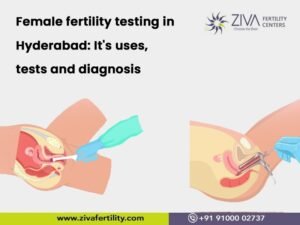Infertility is more common than you think. According to the American Society of Reproductive Medicine (ASRM), approximately 11% of the population is affected by infertility. That is 6.7 million women and men in India.
The treatment of infertility depends on the cause and surrounding factors. Today, despite a year of active attempts, women and men who are having trouble getting pregnant have many options. Fortunately, infertility is not the end; there are alternative methods, drugs, and procedures that can be used to start a family.
Conception and pregnancy
Women experience ovulation once a month. This is the time when one of the ovaries releases the egg. The egg then passes through the fallopian tube to the uterus, where it is fertilized by sperm. The fertilized egg then attaches to the endometrium or cervix and is fixed there by the uterus. If there is no sperm to fertilize the egg, it will be discharged from the uterus during menstruation.
If the woman encounters any problems during this process, it may be a sign of infertility. Where the problem lies in the process, determine the type of treatment you need. The most common cause of infertility is ovulation. Hormonal problems or imbalances can lead to diseases such as polycystic ovary disease. Factors such as obesity, unhealthy eating habits and smoking also increase the risk of infertility. Excessive drinking and high stress can also increase the risk of infertility.
Types of treatment for women may include:
- Intrauterine insemination: This method uses a small flexible tube called a catheter to insert a specially cleaned and prepared sperm directly into the uterus. It can be used for low sperm count or cervical mucus problems. This method is usually combined with ovulation drugs.
- Ovulation medications: These drugs help regulate ovulation time. They stimulate the growth and release of mature eggs. They can also help correct hormonal problems that may affect the endometrium. Ovulation drugs can stimulate the release of multiple eggs. This increases the chance of twins and multiple births. Some common drugs include clomiphene citrate, human menopausal gonadotropin. Follicle Stimulating Hormone (FSH) and Luteinizing Hormone (LH) are the medications
- Surgery: Surgery can be used to treat or repair blocked fallopian tubes or endometriosis. This can be done by laparoscopy. A small telescope inserted into the abdominal or pelvic cavity allows the doctor to observe the internal organs in laparoscopy. Some infertility treatments can be done with instruments inserted through a laparoscope.
- Assisted reproductive technology (ART): For some couples, more advanced treatment is needed. For most forms of ART, sperm and eggs are fertilized in the laboratory. The fertilized egg is then transferred to the woman’s uterus, where it can implant and grow. Although ART programs are usually expensive, many programs have been successfully used. These include:
- In vitro fertilization (IVF) involves taking out women’s eggs and fertilizing them with sperm in the laboratory. The embryo is then transferred through the cervix to the woman’s uterus. Most couples transfer two embryos. In some cases, more can be transferred. IVF is the most common form of ART. It is usually the treatment of choice for women with blocked, severely damaged or blocked fallopian tubes. IVF is also used for endometriosis or infertility caused by malefactors. In vitro fertilization is sometimes used to treat long-term infertility couples who cannot get pregnant through other treatments for unknown reasons.
- Intracytoplasmic sperm injection (ICSI): A single sperm is injected directly into the egg in this process. This method is most commonly used to help solve the problem of male factor infertility.
- Gamete intrafallopian transfer (GIFT): This involves using a fibre optic instrument called a laparoscope to guide the transfer of unfertilized eggs and sperm through a small incision in the abdomen and into the woman’s fallopian tubes. GIFT is only for women with healthy fallopian tubes.
- Zygote intrafallopian transfer: (ZIFT): This involves fertilizing the female’s eggs in the laboratory. Then the fertilized egg (fertilized egg) is laparoscopically guided and transferred to the fallopian tube. ZIFT is only used for women with healthy fallopian tubes.
- Donor eggs. This involves transferring embryos from donors to infertile women. The donor waives all parental rights to the resulting children. ART using donated eggs is more common in older women. The probability of implantation of a fertilized egg is related to the woman’s age who produced the egg. Egg donors are usually in their 20s and 30s.
- Embryos are cryopreserved: In this method, embryos are frozen for later transfer. This method is usually used when the IVF cycle produces more than one embryo that can be transferred. If necessary, the remaining embryos can be transferred in future cycles.
Types of treatment for men may include:
There are a variety of treatment options available for male factor infertility. Treatment may include:
Assisted reproductive technology (ART): This type of treatment may include:
- Artificial insemination: This includes placing large amounts of healthy sperm in the opening of the cervix or directly into the woman’s uterus.
- IVF, GIFT, and other techniques: These have been used to treat male infertility. As in artificial insemination, IVF and similar technologies offer the possibility of preparing sperm in the laboratory. In the laboratory, the egg will be exposed to the optimal concentration of high-quality motile sperm.
- Microsurgical fertilization (microinjection techniques such as intracytoplasmic sperm injection or ICSI): A single sperm is injected into the egg for this treatment. Then fertilization takes place under the microscope.
- Medical treatment: Some infertile men have hormonal problems and can be treated with hormonal therapy. Hormonal imbalances caused by hypothalamus, pituitary and testicular problems directly affect sperm development. Medications may include gonadotropin therapy, antibiotics, or other medications.
- Male infertility surgery: Surgery is performed to repair anatomical problems that prevent sperm production and maturation or ejaculation. Surgical removal of scrotal varicose veins (varicocele) can sometimes improve sperm quality.
Conclusion:
Infertility is a problem of the reproductive system. It will affect the body’s ability to reproduce. It may be caused by system problems in the male system, the female system, or both. Infertility is not just a problem for women. In about half of infertile couples, men are the only cause. If, after one year of unprotected sex, a woman over 35 does not conceive or has a known problem causing infertility after six months, the couple is considered infertile.
At that time, meet a Gynaecologist, and take the best treatment. Depending on the cause of infertility, infertile couples have various treatment options offered by the doctor. Drug treatment or surgical repair can cure most infertility. Although infertility can be a challenging experience for you and your partner, the good news is that it can usually be treated. Don’t despair! For more information and best treatment for your condition, contact Ziva Infertility Center at +91-9392834024, +91-9100002737.
















